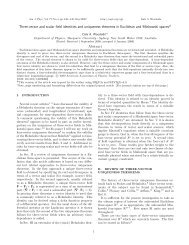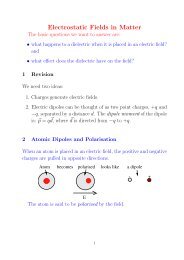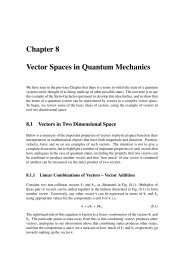AOS News - The Australian Optical Society - Macquarie University
AOS News - The Australian Optical Society - Macquarie University
AOS News - The Australian Optical Society - Macquarie University
- No tags were found...
You also want an ePaper? Increase the reach of your titles
YUMPU automatically turns print PDFs into web optimized ePapers that Google loves.
<strong>AOS</strong> <strong>News</strong> Volume 25 Number 1 2011Lidar Work inAdelaidethe early yearsby Murray HamiltonLidar for studying the atmosphere is a significantpart of the activity in optics at <strong>The</strong> <strong>University</strong> ofAdelaide. It isn’t widely appreciated, even withinthe current lidar group, that this activity has quite a longhistory. This article aims to summarise the early historyof lidar at Adelaide, up until around 1995.Figure 1. Frontispiece of Bartusek’s <strong>The</strong>sis. Karel Bartusek (left)and David Gambling (right) in front of the lidar van.In mid-1963 Dr Graham Elford (then alecturer in the Atmospheric Physics groupat Adelaide) made a proposal to make alidar in Adelaide, hopefully to see Rayleighscattering from a height of 100 km. WRE(the precursor to DSTO) was sufficientlyinterested in the potential of lidar systems,that a grant from them was negotiated toemploy a design engineer (Colin Vaskess)and to supply funds for equipment andmaintenance. A post-Honours student,Karel Bartusek elected at the end of 1963to undertake the work for his PhD.<strong>The</strong> following year Elford was on studyleave at the Smithsonian AstrophysicalObservatory, Boston, USA, and attachedthere to the Radio Meteor Group wherehe met G. Fiocco from MIT. Fiocco andSmullin had just published a paper onlidar studies of dust in the atmosphere, andclaimed to have observed meteoric dustat 120 km. (We now know that there arelayers of sodium, potassium and iron, all ofmeteoric origin, at around this height, andthe sodium layer is the basis of artificialguide stars for adaptive optic astronomy.)Figure 2. Profiles of backscatter coefficient in the stratosphere (from SA Young’sthesis).Elford was skeptical of the claim, but wasintrigued and hoped to further this workwith the lidar then under constructionin Adelaide. He also visited a laser firm,RCA, in Boston which subsequently wascontracted to build an optical transmitterfor the Adelaide lidar. This was basedaround a ruby laser emitting 1 J pulses.David Gambling joined the groupin 1965, for a PhD that also involvedusing the lidar for optical studies of thetroposphere, stratosphere and mesosphere.Preliminary lab testing took most of 1965.WRE loaned an equipment caravan,inside of which the whole lidar system waseventually installed, although the lidar wasinitially operated at the Mt Torrens fieldstation in the Adelaide Hills.<strong>The</strong> design parameters for the lidartransmitter were never achieved and thislimited the system to optical studies thestratosphere, rather than the mesosphereas well. Nevertheless this was the firstlidar used to probe the atmosphere in theSouthern Hemisphere.In April 1969 the first profiles ofoptical scattering to a height of 60 km wereobtained, and in late 1969 Bartusek andGambling compared twilight observationsof aerosols with lidar observations. <strong>The</strong>19
















